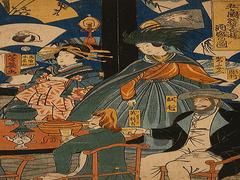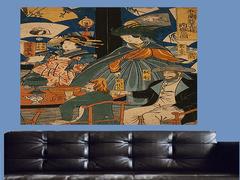The history of Japanese woodblock printing, known as "Moku Hanga," spans several centuries and has had a profound impact on the art and culture of Japan. The technique originated in China but was adapted and refined by Japanese artists, resulting in the unique and exquisite art form that we now recognize as ukiyo-e.
Origins in Chinese and Buddhist Art
The roots of woodblock printing can be traced back to China during the Tang Dynasty (618-907 AD). The Chinese used woodblock printing primarily for religious and Buddhist texts. These early prints were created by carving images or characters onto wooden blocks, inking them, and pressing them onto paper or silk.
The Arrival of Buddhism in Japan
Buddhism was introduced to Japan in the 6th century, and with it came the practice of woodblock printing. Japanese Buddhist monks sought to replicate the sacred texts brought from China, resulting in the development of woodblock printing techniques in Japan. The earliest surviving examples of Japanese woodblock prints are religious in nature, featuring Buddhist deities, sutras, and mandalas.
The Emergence of Commercial Printing
Woodblock printing gradually expanded beyond religious contexts and became more accessible to the general public. By the late 16th century, prints depicting popular subjects like kabuki theater, sumo wrestling, landscapes, and scenes of daily life began to emerge. The invention of movable type in the mid-16th century also contributed to the growth of commercial printing.
The Rise of Ukiyo-e
Ukiyo-e, meaning "pictures of the floating world," emerged as a popular genre of woodblock prints during the Edo period (1603-1868). This period was characterized by relative peace and stability, resulting in the growth of a merchant class and the rise of urban entertainment districts. Ukiyo-e prints reflected the pleasures and diversions of this "floating world" and captured the imagination of the people.
The Pioneers of Ukiyo-e
Hishikawa Moronobu, an artist of the late 17th century, is considered one of the pioneers of ukiyo-e. He depicted scenes from the theater, teahouses, and the pleasure quarters of Edo (present-day Tokyo). Moronobu's prints were characterized by bold lines and monochromatic compositions.
The Golden Age of Ukiyo-e
The 18th and 19th centuries marked the golden age of ukiyo-e, with the emergence of renowned artists who refined and elevated the art form. Kitagawa Utamaro became famous for his elegant portrayals of beautiful women, capturing their grace and sensuality. Katsushika Hokusai created iconic prints, such as "Thirty-Six Views of Mount Fuji," including his most famous work, "The Great Wave off Kanagawa." Utagawa Hiroshige depicted landscapes and nature with great skill and sensitivity, leaving a lasting impression on the art world.
The Production Process
Creating a woodblock print involved a collaborative effort. The artist would first design the composition, often on paper, which would then be transferred to separate wooden blocks. Skilled carvers meticulously carved the image into the blocks, one block for each color or element of the composition. The printer applied ink to the carved blocks and pressed them onto paper, resulting in the final print.
Legacy and Influence
Ukiyo-e prints had a significant impact on Japanese society, providing a window into the popular culture of the time. They served as a form of mass communication, disseminating information, entertainment, and fashion trends. Ukiyo-e also influenced Western artists during the late 19th century when Japan opened up to the world. Artists such as Vincent van Gogh, Claude Monet, and James McNeill Whistler were inspired by the flattened perspective, asymmetrical compositions, and exploration of light and color in ukiyo-e prints.
Preservation and Revival
While the popularity of ukiyo-e declined in the late 19th century with the advent of photography and Westernization, efforts were made to preserve and revive the art form. Today, museums and galleries worldwide showcase collections of ukiyo-e prints, ensuring their historical and artistic value is recognized and appreciated. Traditional woodblock printing techniques are still practiced by dedicated artisans, ensuring the continuation of this exquisite art form.
In conclusion, Japanese woodblock printing has a rich and diverse history that has shaped the artistic landscape of Japan and influenced the global art world. From its origins in Buddhist texts to the emergence of ukiyo-e and its enduring legacy, woodblock printing stands as a testament to the creativity, craftsmanship, and cultural significance of Japanese art.
- Unveiling the Artistic Process: Steps of Woodblock Printing
- Japanese Woodblock History - Ukiyo-e: The Floating World Unveiled - A Journey into the Artistic Splendor of Japanese Woodblock Prints
- Nature and Seasons in Japanese Woodblock Prints
- The History of Japanese Woodblock Printing
- The Artistic Journey: Exploring the Rich History of Japanese Woodblock Prints
- The Birth of a Revolutionary Technique: Woodblock Printing and the Tang Dynasty
- The Innovative Legacy: How Woodblock Printing Led to Remarkable Inventions
- The Significance of Japanese Woodblock Printing: A Timeless Artistic Legacy
- Unlocking the Beauty: How to Identify Japanese Woodblock Prints
- Unveiling the Ancient Art: Exploring the Oldest Japanese Woodblock Print




